Gold Wall – Soundproofing System
Shipped by iKoustic from the UK
£0.00 inc. VAT
Shipped by iKoustic from the UK
£0.00 inc. VAT
Turn the volume of the video down to match the noise you’re dealing with for the best results. This video is a digitally recreated noise issue that is then decreased artificially. This is designed to give you a more practical understanding of decibel reduction.
We have a whole selection of dB reduction videos over on our YouTube channel and one for every system we offer.
We are solely a material supplier but we work with specialist installers up and down the UK. You can find a specialist installer close to you by completing this form. Alternatively, you can use a local builder or contractor, we have all of our installation guides online and can offer advice over the phone.
It’s best to think of the MuteClip as a mini shock absorber reducing the transfer of noise vibrations from your wall to a new isolated frame. The dual-density silicone backing makes contact with your wall and surrounds the metal bushing to isolate the clip. This ensures your new system is decoupled from the existing structure.
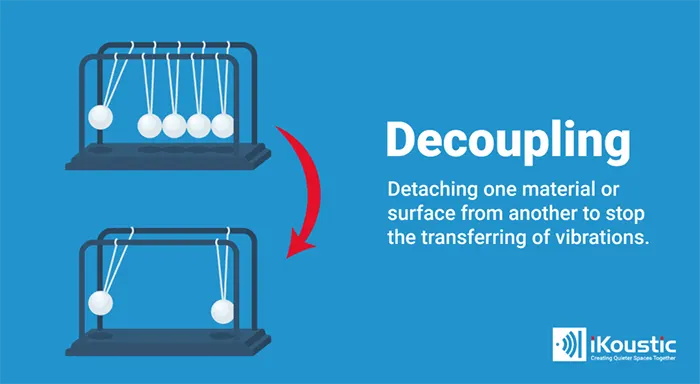
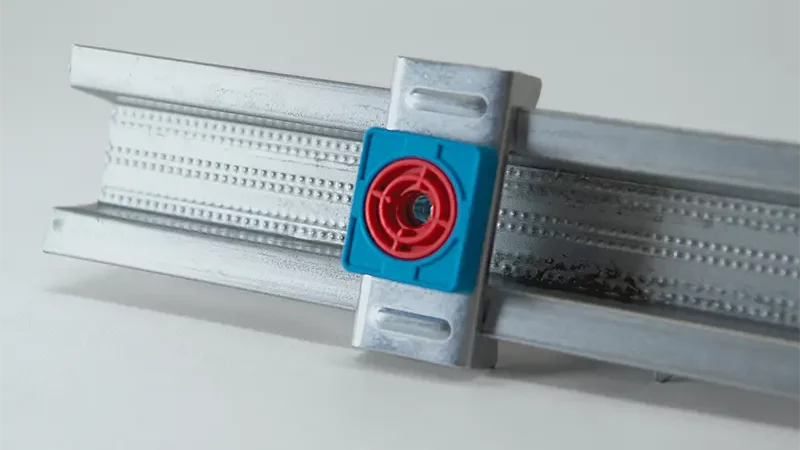
Acoustic plasterboard looks the same as regular sheets, however, it has an increased mass.
Reducing airborne vibrations
The higher mass in acoustic plasterboard allows it to reflect airborne soundwaves and insulate a space.
Acoustic plasterboard can be used on walls and ceilings. It is often used as the structural base to preformed wall panels.
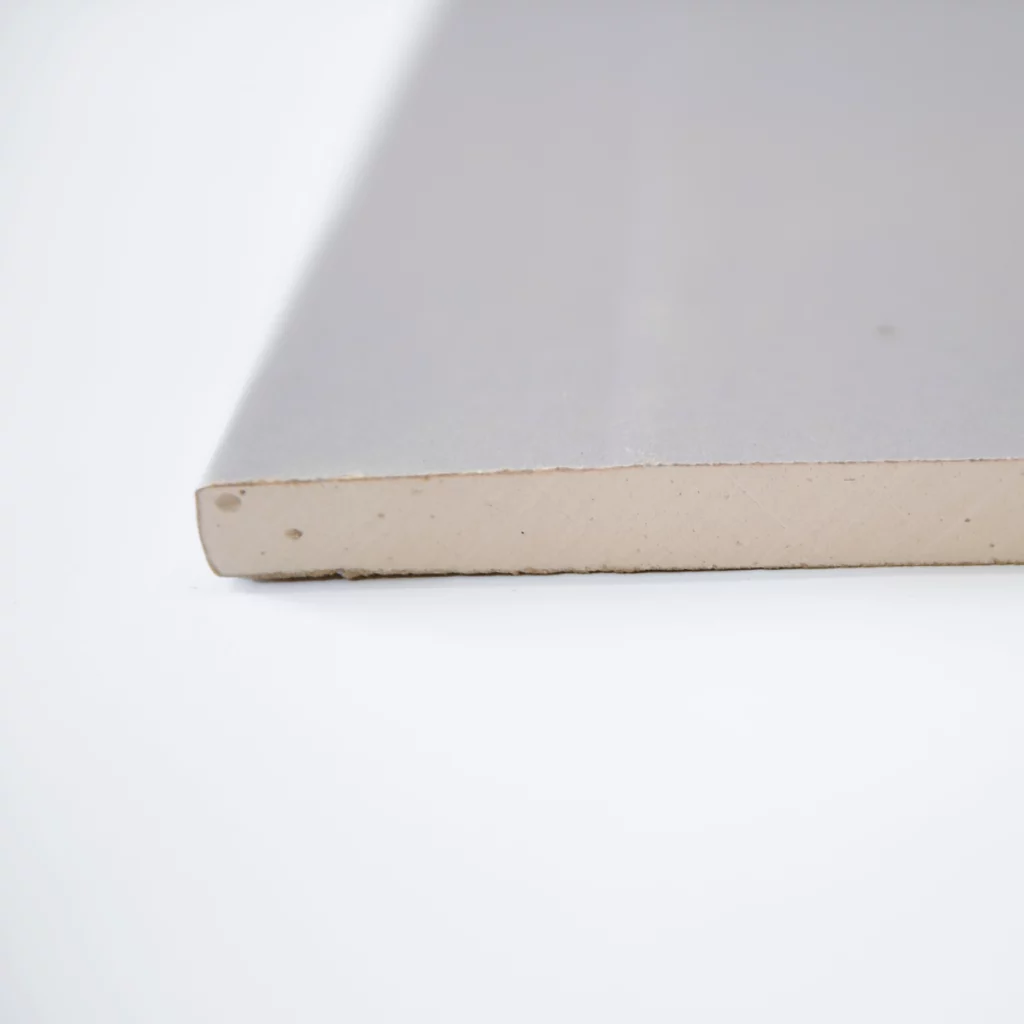
Mineral wool that has a minimum density of 45kg/m3 is considered acoustic. It is available in different densities and thicknesses and is a fairly rigid material.
Reduce airborne noise
The open structure allows sound vibration to travel through and the micro-friction created between waves and fibres exhausts the sound into other forms of energy, like heat.
In any open cavities between joist and stud work.
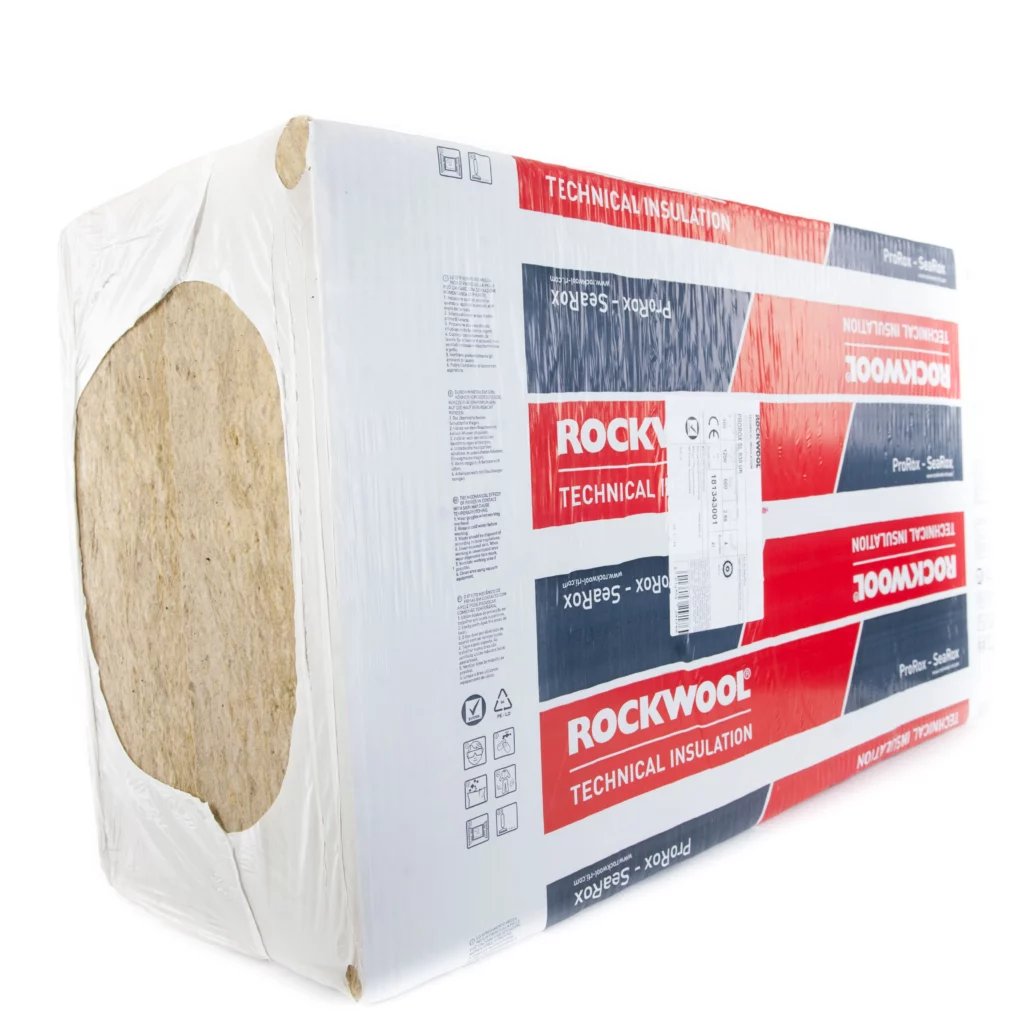
Isolation clips with dual density silicone that support a metal channel, used to support a new wall or ceiling partition.
Airborne noise
Dual density, vibration damping silicone, wraps the screw butt to prevent direct contact between the wall and the metal supporting channel. This isolates vibrations and is the most effective solution for space used.
Walls and ceilings
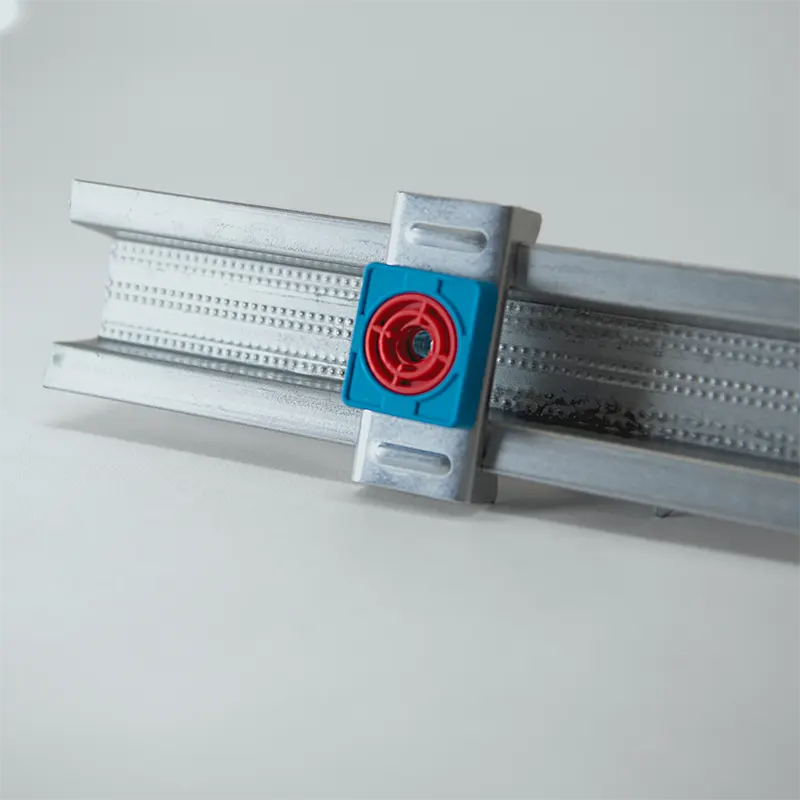
Tecsound is a visco-elastic membrane which comes in different weights and with the option for a self-adhesive back.
Reducing airborne and impact
Tecsound has a very mass, for reflecting airborne sound waves. The visco-elastic quality allows the material to flex and absorb impact vibrations.
Tecsound is a versatile membrane used on walls, floors and ceilings.
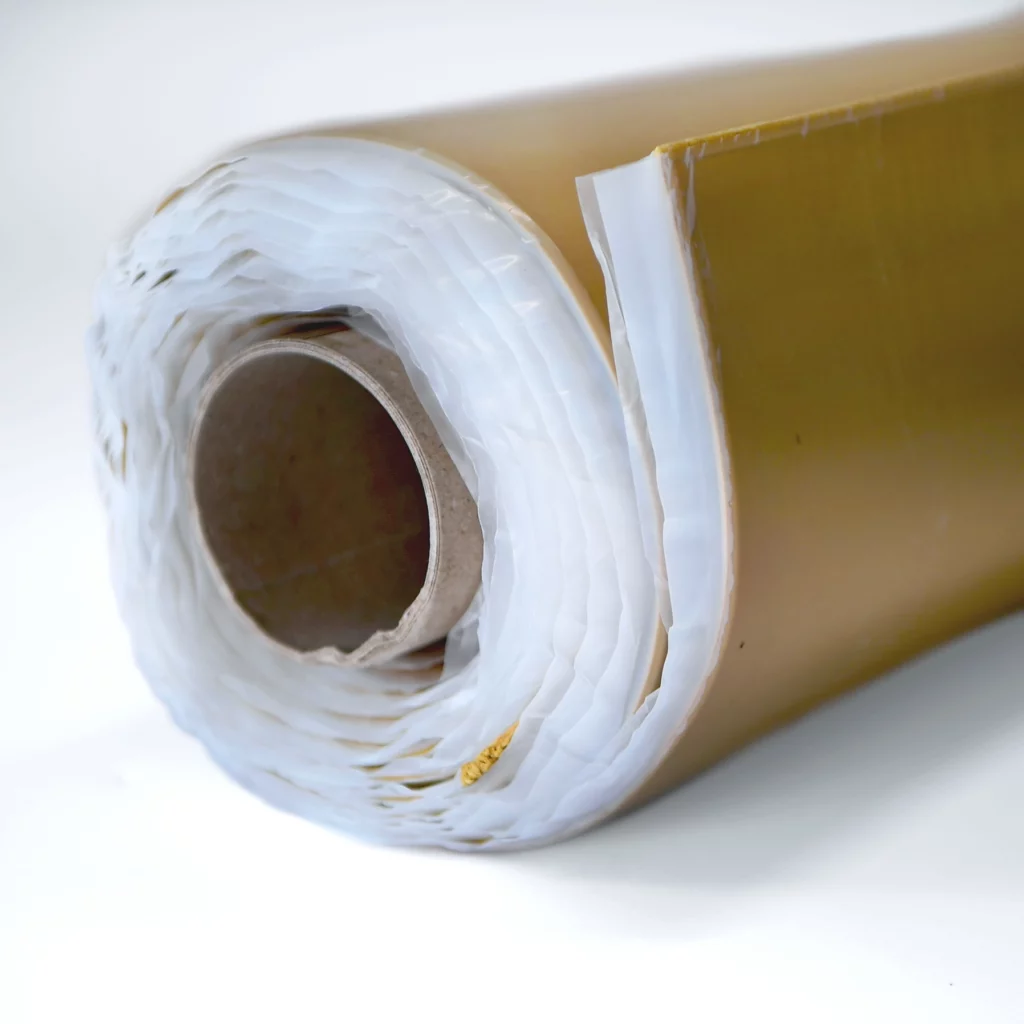
As a general rule, a 2-5mm gap should be left around the perimeter of installed soundproof panels. Into this gap, the acoustic sealant is squeezed.
Flanking transmission
By leaving a gap between materials, vibrations cannot pass from one structure to the next. However, an air gap cannot be left either. Acoustic sealant doesn’t set solid and is the perfect, flexible, material to seal the gap.
Walls and ceilings
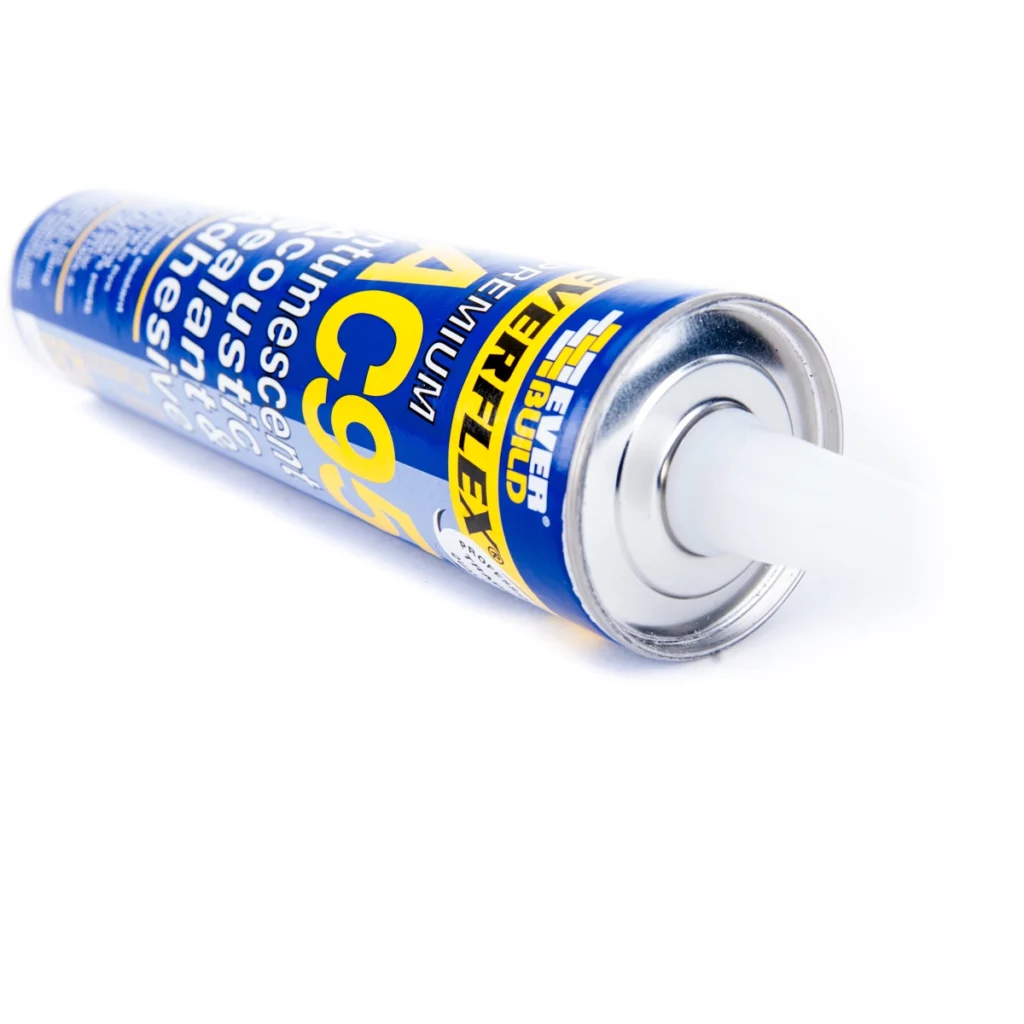
Isolation strips can be used on top of wooden joists before the floor is fitted and on stud work to act as a barrier between the wall.
Reducing flanking transmission
Made of the same rubber crumb as underlays, this non-resonant rubber reduces the transference of vibrations between flanking structures.
Tops of floor joists and outside or stud work.
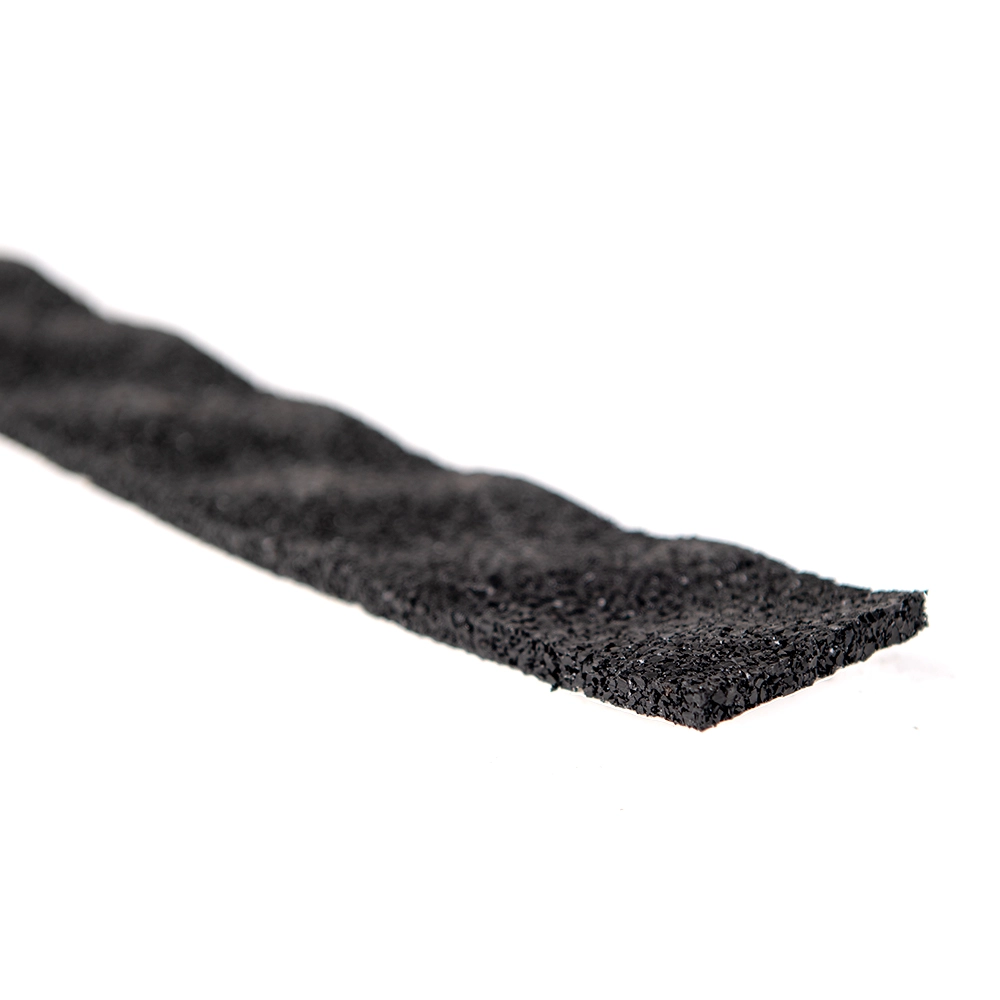
Decibels are how we measure sound but due to the logarithmic nature of the Decibel scale, it isn’t the most intuitive concept to grasp. If you are interested in soundproofing the key thing to take away from this article is that reducing sound by 10dB is a perceived halving of the sound you hear. Lets take a look at some examples….
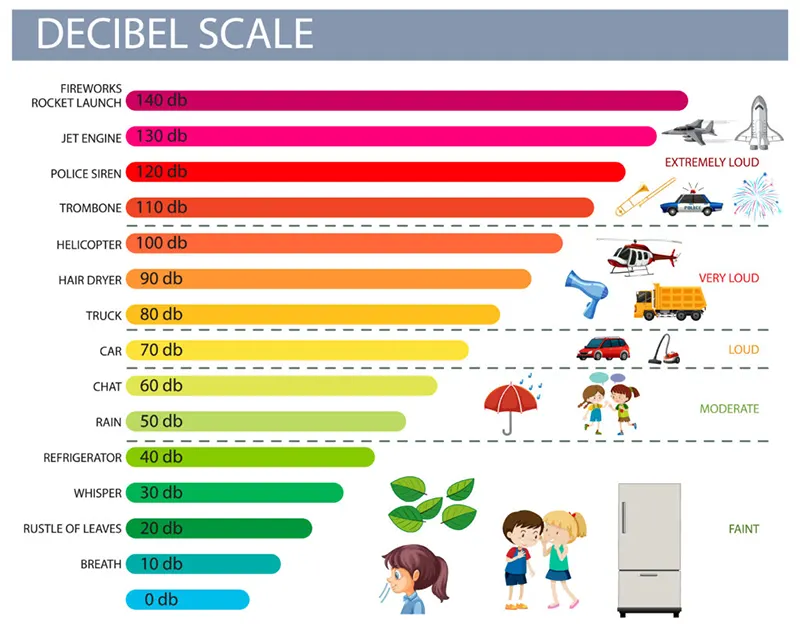
Sound that uses the medium of air to travel through. Common example include talking, music and TV.
Sound generated by two materials coming into contact, sound vibrations travel through the materials. Common examples are footsteps and washing machines.
When sound vibrations travel over, under or around a barrier. This could be using holes in walls made by light fixings, shelves or picture hooks. Another common example is pipe work which can vibrate with sound waves and travel between various rooms.
A method of soundproofing which reduces points of direct contact between two surfaces or places a vibration resistant material between them. Common examples are isolation clips (MuteClips), secondary stud walls and isolation strips on stud work.
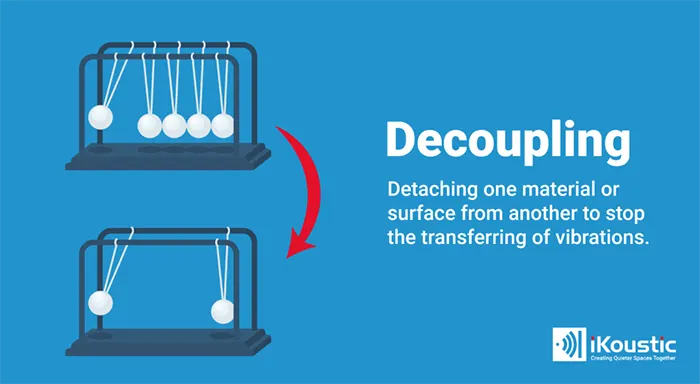
A method soundproofing that uses materials of high mass to reflect airborne noise within a space. This prevents sound escaping a space or entering a space.
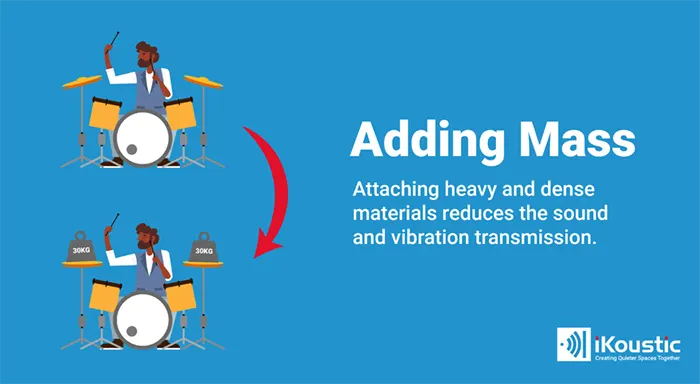
A method of sound control which uses materials with open structures, such as foams and loose woven fibres, to damp sound. This reduces the reflection of sound waves within a space which would lead to reverberation and the amplification of sound.
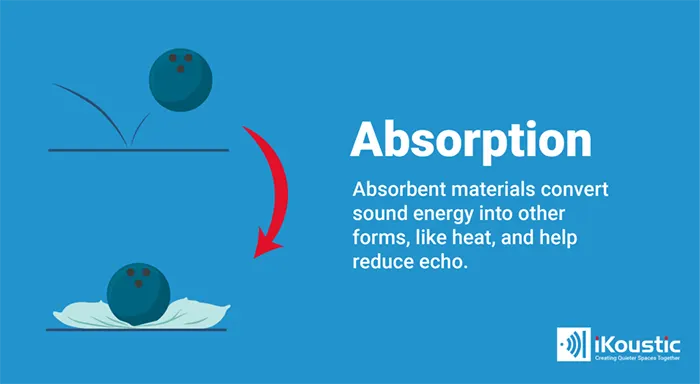
To reduce impact noise, which uses the structure to travel through, an ideal solution is to decouple surfaces wherever possible. This will reduce the points of contact at which vibrations are able to pass from one structure into the next.
An example of this could be a ‘floating floor’ which would make contact with the ceiling below in fewer places and reduce the volume of footsteps. Alternatively, stud walls can be rested on isolation strips which will reduce the amount of vibrations that can travel from the floor into the walls.
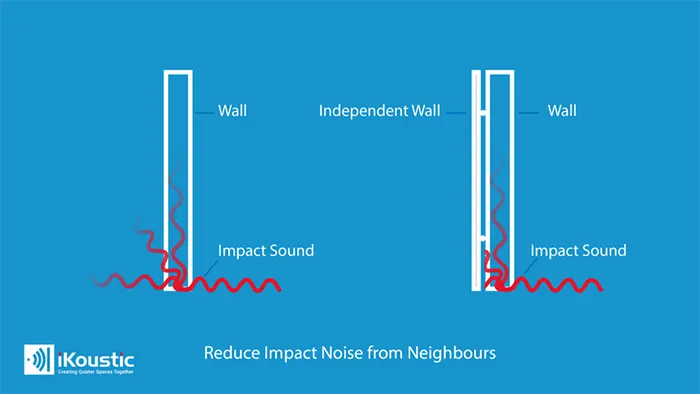
Airborne is reduced by using materials of high mass to insulate a space. This works as the sound vibrations in the air don’t carry enough energy pass through the material, as it’s too dense t make vibrate. Instead, they are reflected away, this works to keep sound inside a space and prevent sound entering the space, too.
Materials of high mass can be added to walls, ceilings and floors and are often used to reduce ‘noisy neighbour’ disturbances.
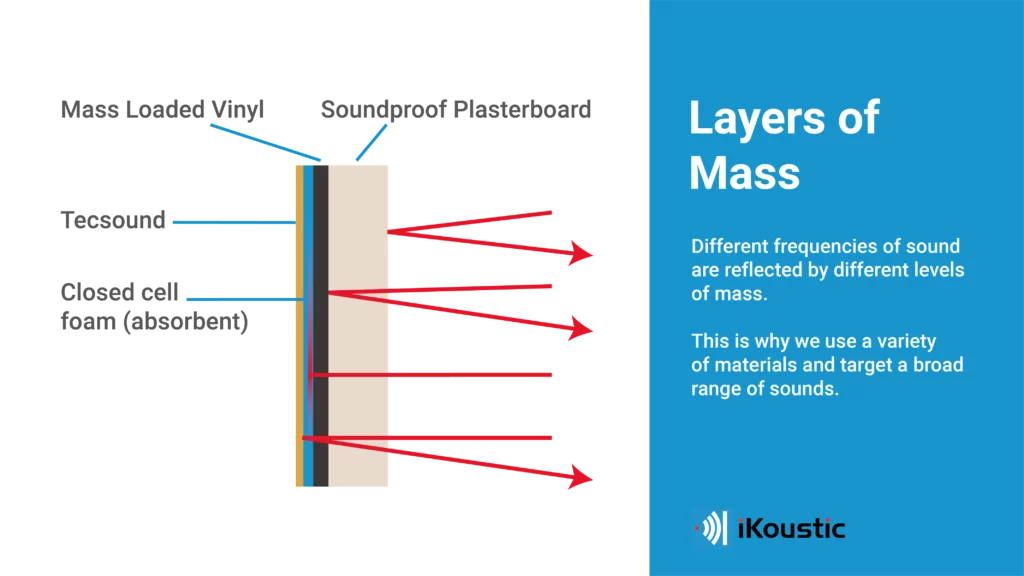
Flanking transmission can be reduced in a multitude of ways but first and foremost the weaknesses need to be identified. These could be fixings for lights, pipe work or screws in walls. Any unavoidable weaknesses, such as pipes, can be treated as individual problems.
For example, there is soundproofing pipe wrap that can be installed to help isolate the system. For light fixings, there are sound control caps that can be fitted and likewise for electric sockets. When screws and nails are fixed to walls, it’s best to avoid drilling them further than necessary.
So that’s our whistle-stop tour of the soundproofing world, obviously this only scrapes the surface. If you want to learn more check out our blogs or YouTube channel.
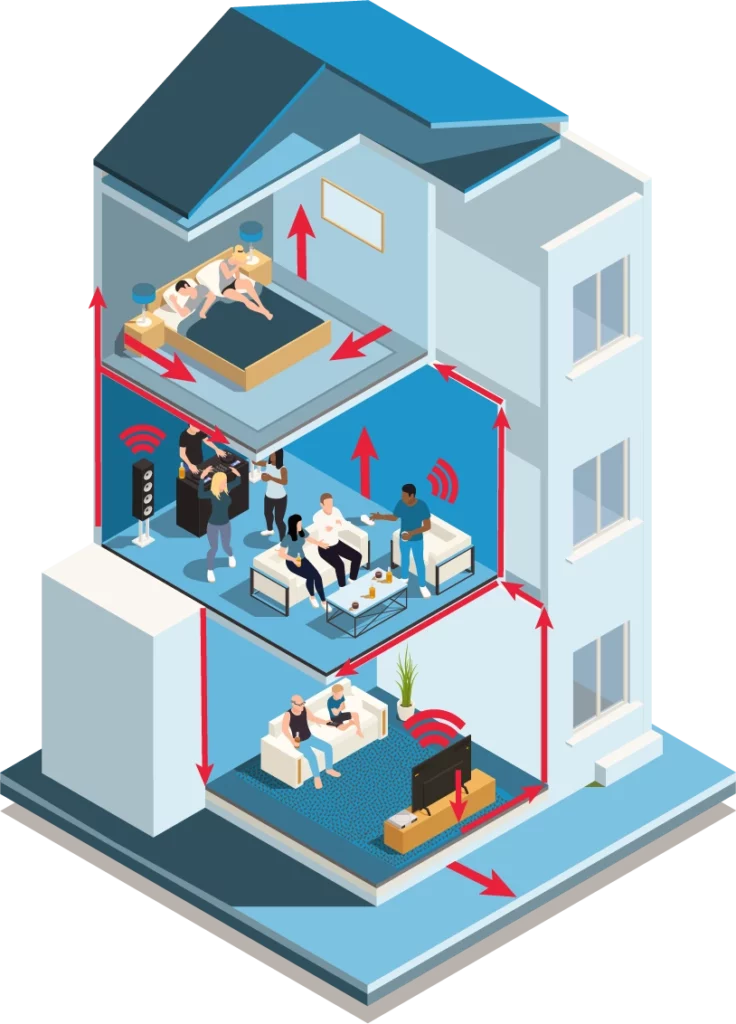
Yes, you can install our wall soundproofing yourself if you don’t want to hire a soundproofing installer. We recommend that you’re a confident DIYer with some experience of hand tools and check to make sure you have the appropriate equipment before starting.
Installation Guides
Installation guides are available to download as a PDF from system and product pages. In these guides, you’ll find the tools required, the method for installation and some helpful diagrams. Please take a read of these before committing to a DIY install.
Installation Videos
We also have a range of installation videos to help you, these can be found on our YouTube channel.
Contact Us
If you need any extra advice when it comes to installing your wall soundproofing then you can also get in touch with us.
You can find a soundproofing installer using our UK wide network. Simply fill in our form and your local soundproofing installer will be in touch.
Alcoves can be soundproofed with the same materials that are used for regular walls. Alcoves should be approached methodically and it is good to plan your install before starting. The back wall should be treated first, with the usual 2-5mm gap around the perimeter of acoustic boards. This ensures that flanking transmission is reduced and resultant gaps can be filled with acoustic sealant.
As the diagram illustrates, the additional walls can be treated in synchrony, ensuring that the correct overlap is created at corners. Once again, the acoustic boards should not make contact at corners and gaps created can be filled with acoustic sealant.
Depending on your available space and the severity of your noise complaint, the full MuteClip double system can be used to great effect. If you have a smaller space, slimline alternatives can be installed instead. To get more advice about which system is best for your room, contact our technical team.
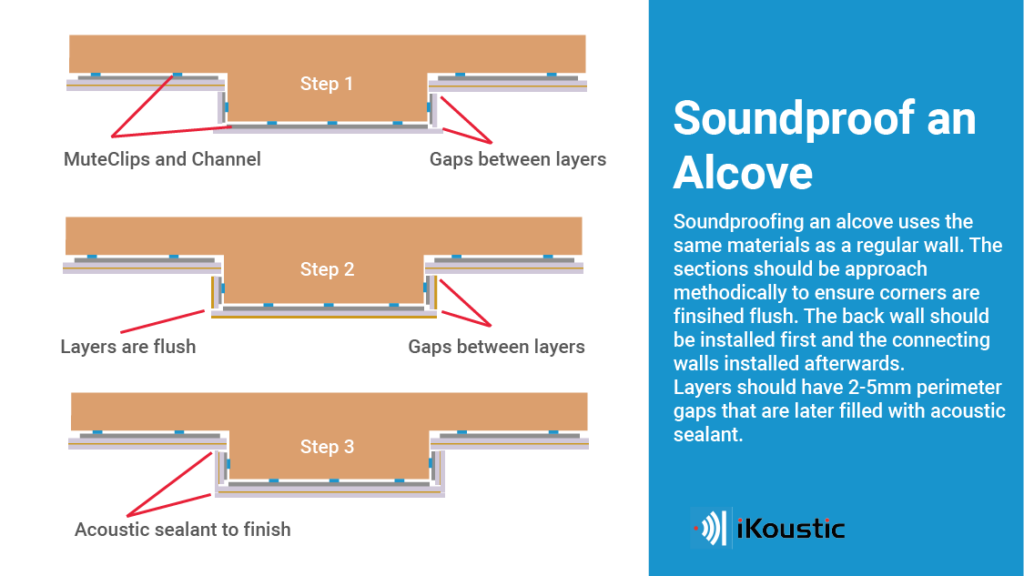
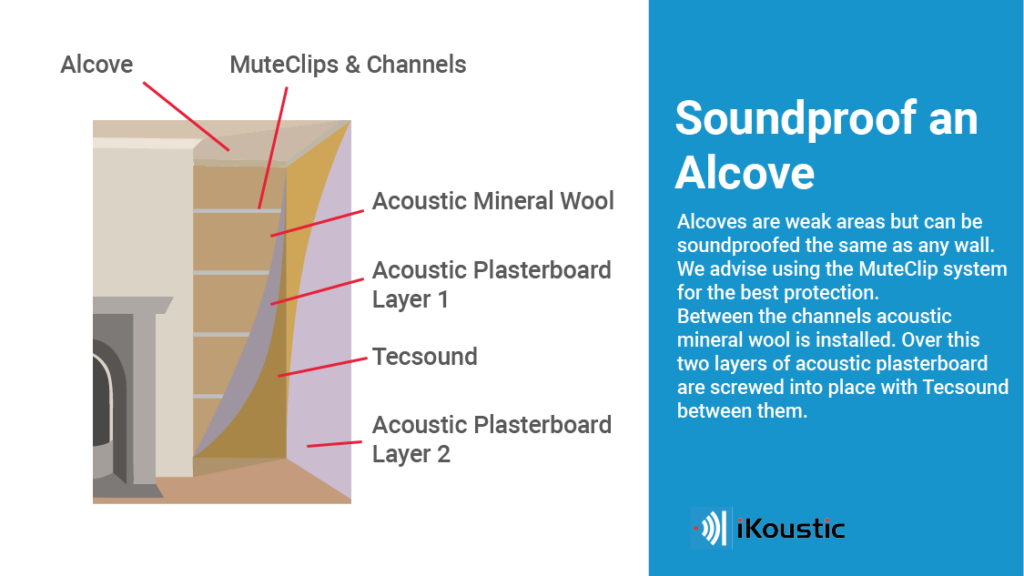
As an RSJ is made from steel, a rigid material, it can conduct sound vibrations through your building. We used a multifaceted approach to treat this issue which inhibits sound traveling along the RSJ and radiating out into your room.
To dampen vibrations traveling along the metal, a layer of self adhesive Tecsound can be used to cover the metal joist. This has impressive vibration dampening qualities thanks to its elastic makeup.
Around this, acoustic mineral wool is packed to reduce reverberation in cavities and isolate the structure from the final layer which is acoustic plasterboard. Acoustic plasterboard has more mass than regular plasterboard and provides resistance to airborne noise.
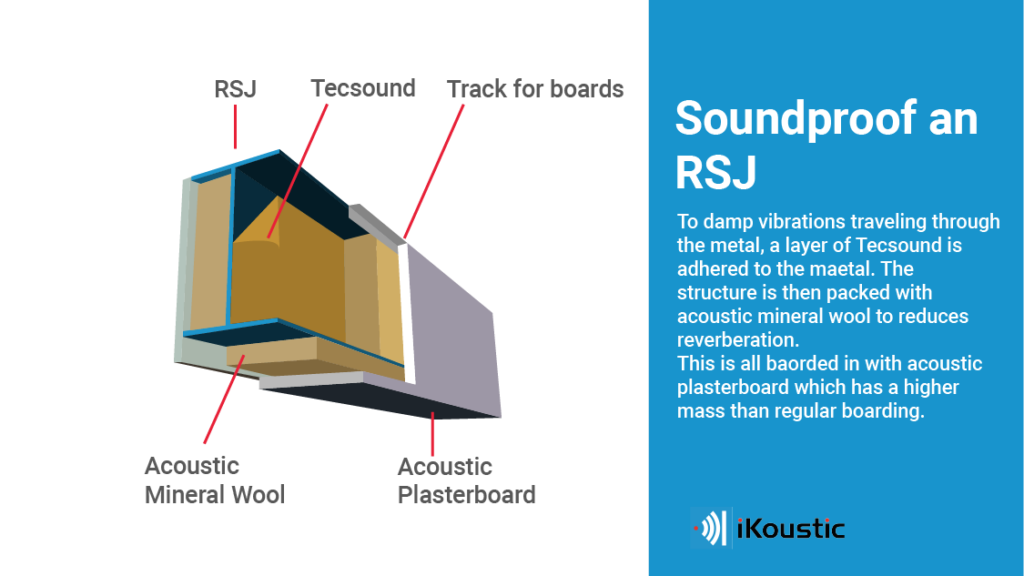
Noise from your plumbing, like downpipes can be easily fixed with one material. Tecsound F55 AL uses three different soundproofing materials in one self-adhesive pipe wrap.
The inner layer of aluminum is self-adhesive and wraps around your problem pipe. The middle layer is a vibration dampening membrane of Tecsound, which is visco-elastic. This reduces the transmission of vibrations along the pipe.
A final layer helps absorb noises that try to radiate out of the pipe. The acoustic felt has an open structure that traps soundwaves and reduces reverberation.
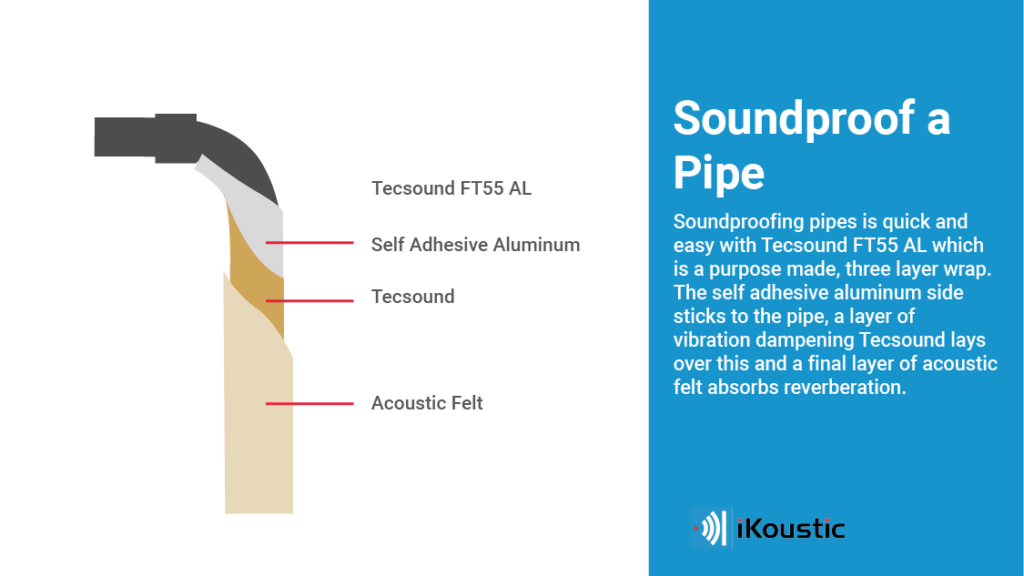
Sockets are naturally weak areas of walls as the air gap can easily transmit airborne noises like talking and music. To improve the sound resistance of sockets, an acoustic insert can be placed behind the facing. This creates a barrier to airborne noises and improves the overall performance of your wall by reducing flanking transmission.
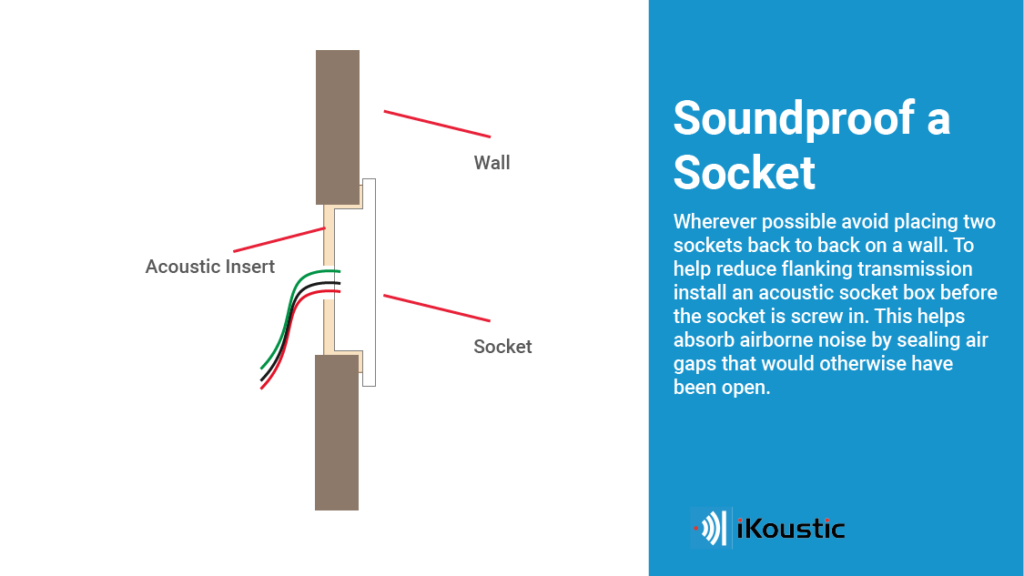
Our reduction figures in dB denotes the improvement made to the wall, floor or ceiling. Brick walls already have a resistance of around 40dB and most sites show this figure in addition to the improvement figure obtained for the soundproofing system. This is why some sites show systems which achieve a reduction of over 60dB for a wall; it’s the resistance of the existing wall and their system combined, but we only show the figure for the system.
As every wall, floor and ceiling will resist sound differently, and the tested structure may have an especially high resistance to sound to begin with, we prefer to show the improvement figure achieved by a soundproofing system. This makes it easier for you to compare our systems and get a realistic idea of how much noise each soundproofing system will resist.
If you have any questions about data, how to read it or which soundproofing intervention you need, please get in touch with our team who will be happy to help.
dB: Decibel, which is used to measure the level of sound.
dBA: A-weighted decibels, these take into account human sensitivity to different frequencies of sound.
ΔdB: Delta decibels, which represent the change in sound level before and after the soundproofing intervention.
ΔLlin (Delta L-linear): This represents the change in sound levels on a linear scale. For example if the baseline noise level is 60dB and after soundproofing it had reduced to 50dB the ΔLlin would be 10dB.
ΔLw (Delta L-weighted): Arguably more important than the former, this represents the change in dB after soundproofing using the A-weighted scale. This therefor takes into account the human perception of sound reduction by emphasising the frequencies which the human ear is most sensitive to and de-emphasising others. In essence, ΔLw provides a more meaningful measurement of sound reduction.
Resistance to fire for our most popular system materials. Euroclass ‘A-F’ rating is for the ability of the material to catch fire, A1 and A2 rates the material as non-combustible. The ‘s’ rating, (1-3), is for the severity of smoke with s1 being the lowest. Lastly the ‘d’ rating is for droplets, d0 meaning no droplets.
Our most popular materials have the following resistance to fire:
Acoustic Plasterboard: Euroclass A2-s1, d0
60kg/m3 Acoustic Mineral Wool: Euroclass A1
100kg/m3 Acoustic Mineral Wool: Euroclass A1
Tecsound SY50: EN 13501-1:B-s2,d0
Tecsound SY70: EN 13501-1:B-s2,d0
Tecsound SY50 ALU: EN 13501-1:B-s2,d0
If you are looking to specify this product for a build, please refer to our downloads tab for technical product or systems information.
Technical Support
Should you require further technical assistance in specifying our products, please contact us.
BIM Objects
iKoustic also supply a selection of BIM objects via our NBS profile, which can be found here.
Important Information
Our products contain a high level of mass. If there are any structural concerns you will want to consult a Structural Engineer to discuss your requirements.
*Our Typical Performance Results and Noise Reduction Guidance are provided to indicate the results that have been achieved in previous tests but are not guaranteed to a specific site as multiple factors can affect this, you can view their variants on our ‘Featured Systems’ tab.

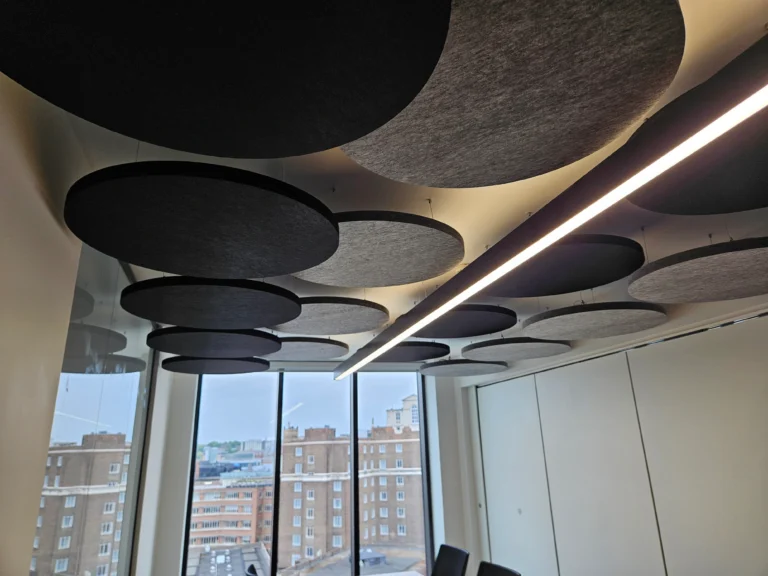
If you place an order online it’s likely we will call to discuss delivery to make sure it runs as smoothly as possible. Deliveries can arrive on a large vehicle. If there are access issues or HGV restrictions, please do let us know in advance as our website options are given in good faith of no restrictions. All of our deliveries must be signed for so you will need to ensure someone is on the premises on the day of delivery.
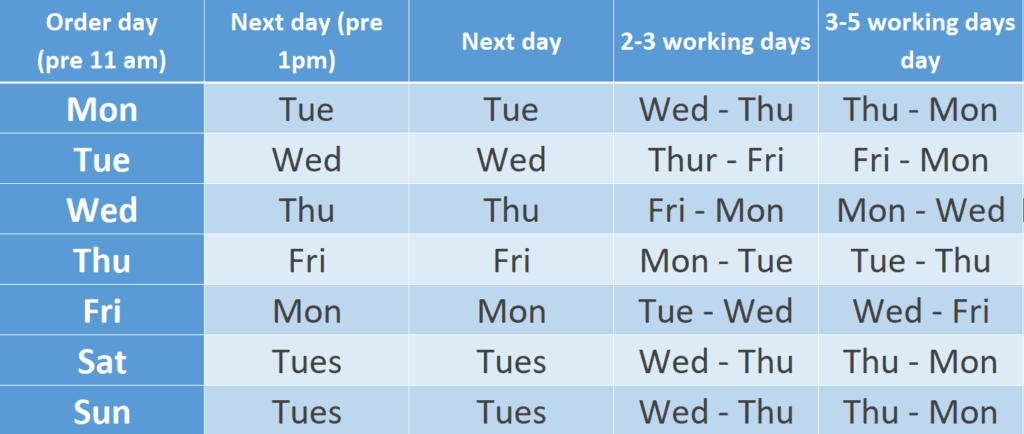
No products in the cart.